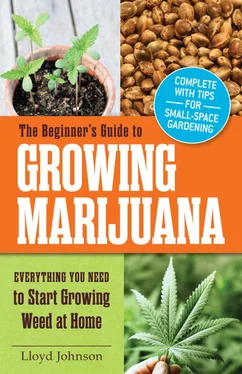Some growers use a garden tiller. These can range in size from tiny eggbeaters that are useful for raised beds or starting plant site holes to riding tractors with big tiller attachments run by hydraulics.
Generally, heavy tilling of grow sites is a less than productive use of good soil. However, there are times when a tiller is very useful, especially when starting from unimproved soil or for incorporating tilth-building materials like spoiled hay or mushroom compost.
Tillers can be rented by the day; this is sometimes the best solution for the minimal use you will make of such an expensive machine. Also, remember that tillers run on gasoline or diesel, neither of which is inexpensive. If you do purchase or rent a tiller, figure on buying a few gas cans as well; you are going to have to transport and store fuel.
Soil Amendments
Soil amendments are another expense factor. These include potting soils, composts, minerals, and soils by the yard. Depending on the overall size of your crop, soil amendments can cost anywhere from a few hundred to a thousand dollars. Remember, you will also have to use fuel and time to procure soil supplies, and large amounts will require using a truck. As noted earlier, outdoor growers have the advantage of actually being able to build optimum soil. This takes time, however, and a first-year crop is going to need good soil immediately.
Drying
Once you are drying the crop, consider the expense for a dedicated building or drying room, purchasing fans and dehumidifiers, and the accompanying electrical bills to power them. You will also need heavy-gauge wire and hardware to hang it, or racks for hanging the plants, as well as clean glass or plastic for storage after curing is completed.
The basic requirement for cannabis is nutrient-rich, well-drained soil. A good starter mix is one-third sandy loam for drainage, one-third compost you have made, and one-third organic bagged soil.
You could just start out with organic bagged soil, as it usually contains sandy loam and is an excellent mix of other essentials, but it is very expensive. Using sandy loam is important for drainage and also for a slightly firmer soil texture. Sandy loam can be purchased in bulk at garden centers and by the yard in rural areas.
You can improve a reasonable soil with good organic gardening practices until you have ideal soil. Loam is the most desirable and is made up of 40 percent sand, 40 percent silt, and 20 percent clay. In this mix, the plant can access the good nutrients in clay soil because there is sufficient air available. When you are mixing your own soil, strive to create a similar blend to loam. Plant roots need air to access food, and while a dense, compacted soil like clay may have lots of nutrients, they remain unavailable to the plant due to lack of air. Good aeration also stimulates beneficial bacterial activity, allowing the plant to use more organic matter.
Soil Considerations
Compacted soil speeds up moisture loss; in hard, packed soils, water rises very rapidly to the surface and is lost through evaporation. This can lead to a much larger water bill than you initially anticipated for your grow.
You must also be alert to the acidity or alkalinity of the soil mix. Cannabis prefers a soil that is not too acidic and not too alkaline; a pH of 6.5 is just about perfect. Some growers swear by a slightly lower pH; most estimate the range for soil-grown cannabis is 6.5 to 7.5.
Humus is important for improving water and nutrient-holding capacities. Humus contains complex organic compounds that remain after the many soil organisms have used and transformed the original material.
The Importance of Soil Dwellers
Living soil organisms decompose organic compounds, sequester nitrogen and other nutrients, and fix nitrogen from the atmosphere, making it available to the plants. Soil organisms interact with one another, with plants, and with the soil. The combined result is a number of beneficial functions including nutrient cycling, moderated water flow, and pest control.
This nutrient cycling and disease suppression is very complex and very much needed for a healthy garden. Dead, chemically treated soils are bad for the environment as well as nonconductive to good plant health and natural disease controls. The wise outdoor grower will work with nature and encourage natural controls.
Choosing the Right Strains
Cannabis breeders have spent years modifying plant characteristics to optimize quality and production. Information about their observation and genetic manipulation is available either through books or on the web, so learning where strains are typically grown can give you your first clue as to what might improve your growing success.
The Classics
Some strains remain classics and are available for years. Others are improved upon and become harder to find as growers prefer the upgraded version. Northern Lights, Big Bud, and White Widow are considered classics. These are strains that have survived the test of time and are readily available via online seed sites.
The best seed sites will list their strains like a good garden catalog; they list provenance, typical characteristics of the strain in appearance, preferred growing conditions, and the qualities of the end product, usually both for productivity and effects. This is very useful if you plan to breed and fine-tune a strain of your own that is ideally suited to your tastes and your particular microclimate.
Where to Grow
Outdoor plants need an environment to which they are genetically predisposed. Pure sativa strains that do well in California or in the southern parts of the United States do not finish as well in the shorter growing seasons farther north.
The northern parts of the United States can be considered quite a cold climate. The outdoor grower in this region should use strains specifically bred for colder climates. These are mostly indica or indica/sativa mixes. Some of these strains are commercially available, like a Northern Lights crossed with Big Bud or White Widow. It is important to have strains that can finish in the shorter northern growing season.
The southern part of the United States is a mild and warm climate, and many strains can be grown outdoors in this region. Pure indica, pure sativa, and hybrid strains can all be used. Pure sativas particularly like long growing seasons and lots of warmth.
Special Considerations
Due to the outdoor cycle’s long growing period and chances of rain soaking the plant near harvest time, a plant with a tree-like structure is more suited to an outdoor grow. Its air circulation is better than a super-bushy, dense structure that is more prone to molds if the leaves get wet.
If you are acquiring cloned strains from an indoor grower, and they are commercially available as well, it is worthwhile to look up online to see how it performs outdoors. A clone raised outdoors may perform differently than its mother grown indoors.
The Growing Cycle (Overview)
We’ll discuss the outdoor growing cycle in more depth in Chapter 11, but for now, keep in mind that the you must determine when spring really starts in the area where you live. California growers have one of the best climates in the country for growing outdoor cannabis; they can get their seedlings out early and grow massive sativas without fear that the plants will not finish in time. Other parts of the United States have a long, cool, rainy spring season, and the farther north the area, the shorter the growing season.
Starting the Cycle
The cycle starts when you procure clones or start your seeds. These little ones will need to be nurtured until they reach a safe size to be put outdoors. Remember, clones do not have to be the size of a cutting; this is just when growers generally receive them from the propagator. Clones can arrive sometimes as three- or four-foot tall plants. The downside is that this larger clone is probably rootbound and will experience difficulties as it tries to adjust to real sunlight. The sun is far more powerful than grow lights, and it takes them a little while to adjust.
Читать дальше












